
This will show students what is and is not acceptable when submitting videos in ASL.

This will show students what is and is not acceptable when submitting videos in ASL.
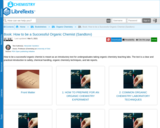
How to be a successful organic chemist is meant as an introductory text for undergraduates taking organic chemistry teaching labs. The text is a clear and practical introduction to safety, chemical handling, organic chemistry techniques, and lab reports.
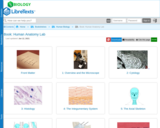
Human biology is an interdisciplinary area of study that examines humans through the influences and interplay of many diverse fields such as genetics, evolution, physiology, anatomy, epidemiology, anthropology, ecology, nutrition, population genetics, and sociocultural influences.
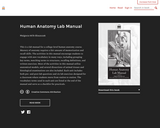
Short Description:
This is a lab manual for a college-level human anatomy course. Mastery of anatomy requires a fair amount of memorization and recall skills. The activities in this manual encourage students to engage with new vocabulary in many ways, including grouping key terms, matching terms to structures, recalling definitions, and written exercises. Most of the activities in this manual utilize anatomical models, and several dissections of animal tissues and histological examinations are also included. Each unit includes both pre- and post-lab questions and six lab exercises designed for a classroom where students move from station to station. The vocabulary terms used in each unit are listed at the end of the manual and serve as a checklist for practicals.
Word Count: 24242
(Note: This resource's metadata has been created automatically by reformatting and/or combining the information that the author initially provided as part of a bulk import process.)
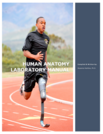
This human anatomy laboratory manual acts as a textbook for undergraduate human anatomy courses. Each chapter has review questions and laboratory activities, and most chapters also have collaborative learning activities. There are 22 chapters total. The chapters are:
Chapter 1: Introduction to Anatomy & Anatomical Terms
Chapter 2: Introduction to Microscopes
Chapter 3: Cell Structures & Types
Chapter 4: How Cells Divide (Mitotic Cell Division)
Chapter 5: Tissues
Chapter 6: Integumentary System
Chapter 7: Introduction to the Skeletal System
Chapter 8: Axial Skeleton
Chapter 9: Appendicular Skeleton
Chapter 10: Articulations (Joints) & Movements
Chapter 11: Introduction to Skeletal Muscles
Chapter 12: The Skeletal Muscles
Chapter 13: Introduction to the Nervous System
Chapter 14: Central Nervous System
Chapter 15: Peripheral Nervous System
Chapter 16: Special Senses of the Nervous System
Chapter 17: Cardiovascular System - The Heart
Chapter 18: Cardiovascular System - The Blood Vessels
Chapter 19: Respiratory System
Chapter 20: Digestive System
Chapter 21: Urinary System
Chapter 22: Reproductive Systems
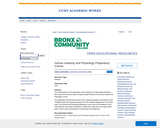
The overall purpose of this preparatory course textbook is to help students familiarize with some terms and some basic concepts they will find later in the Human Anatomy and Physiology I course.
The organization and functioning of the human organism generally is discussed in terms of different levels of increasing complexity, from the smallest building blocks to the entire body. This Anatomy and Physiology preparatory course covers the foundations on the chemical level, and a basic introduction to cellular level, organ level, and organ system levels. There is also an introduction to homeostasis at the beginning.

This course is a basic study of the structure and functioning of the human body. Emphasis will be placed on the interrelationships among the systems. This course introduces the major chemical and biological principles through the study of the human body. Note: This course may be taken alone as a 3 credit biology course OR in conjunction with BIO102 Human Biology Laboratory as a 4 credit biology course.
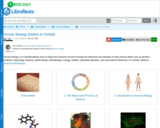
Human biology is an interdisciplinary area of study that examines humans through the influences and interplay of many diverse fields such as genetics, evolution, physiology, anatomy, epidemiology, anthropology, ecology, nutrition, population genetics, and sociocultural influences; it is closely related to physical anthropology.
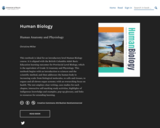
This textbook is ideal for an introductory level Human Biology course. It is aligned with the British Columbia Adult Basic Education learning outcomes for Provincial Level Biology, which is the equivalent of Grade 12 Anatomy and Physiology. This textbook begins with an introduction to sciences and the scientific method, and then addresses the human body in increasing scale: from biological molecules, to cells and tissues, to organs and all eleven organ systems; with an overarching focus on health. The text employs clear writing, case studies for each chapter, interactive self-marking study activities, highlights of Indigenous knowledge and examples, pop-up glossary, and links to resources for extending learning.
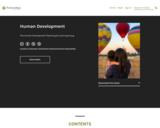
This open textbook is designed for Human Development, a core Psychology course. This course provides a bird’s eye view of major milestones and developmental tasks during each age period, starting at conception and ending with old age.
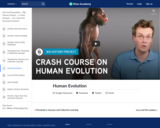
No, we really really did not evolve from monkeys. John and Hank Green explain this and lots of other things related to human evolution. . Created by Big History Project.
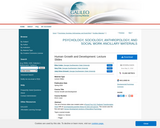
This set of lecture slides was created under a Round Four ALG Textbook Transformation Grant with an accompanying question library for tests and quizzes. The course uses the free and open Human Development sections of Boundless Psychology. Topics covered include:
Nature vs. Nurture
Piaget
Attachment
Freud
Erikson
Kohlberg
Childhood Development
Adolescent Development
Adulthood Development
Late Adulthood

This set of questions for use with quizzes and tests was created under a Round Four ALG Textbook Transformation Grant with an accompanying PowerPoint lecture set. The course uses the free and open Human Development sections of Boundless Psychology. Topics covered include:
Nature vs. Nurture
Piaget
Attachment
Freud
Erikson
Kohlberg
Childhood Development
Adolescent Development
Adulthood Development
Late Adulthood
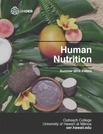
This textbook serves as an introduction to nutrition for undergraduate students and is the OER textbook for the FSHN 185 The Science of Human Nutrition course at the University of Hawai'i at Mānoa. The book covers basic concepts in human nutrition, key information about essential nutrients, basic nutritional assessment, and nutrition across the lifespan.
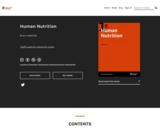
Short Description:
The CK-12 foundation defines a flexbook as a “free and open source textbook platform where one can build and edit collaborative textbooks.” The FNDH 400 (formerly the HN 400 flexbook, department changed its name from Human Nutrition to Food, Nutrition, Dietetics and Health) Flexbook fits this definition. Readers, in addition to having access online, can also download the OER as a digital or printable PDF and EPUB. Data dashboard
Word Count: 76413
(Note: This resource's metadata has been created automatically by reformatting and/or combining the information that the author initially provided as part of a bulk import process.)
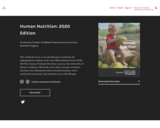
Short Description:
This textbook serves as an introduction to nutrition for undergraduate students and is the OER textbook for the FSHN 185 The Science of Human Nutrition course at the University of Hawai'i at Mānoa. The book covers basic concepts in human nutrition, key information about essential nutrients, basic nutritional assessment, and nutrition across the lifespan.
Word Count: 192929
ISBN: 978-1-948027-08-3
(Note: This resource's metadata has been created automatically by reformatting and/or combining the information that the author initially provided as part of a bulk import process.)
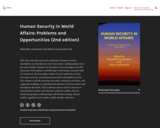
Short Description:
This first and only university textbook of human security, intended as an introductory text from senior undergraduate level up, and includes chapters by 24 authors that encompass the full spectrum of disciplines contributing to the human security field. It is based on the four-pillar model of socio-political security, economic security, environmental security and health security. The chapters include learning outcomes, extension activities, and suggested readings; a comprehensive glossary lists key terms used throughout the book. This textbook can be used in courses on international studies and relations, political studies, history, human geography, anthropology and human ecology, futures studies, applied social studies, public health, and more.
Long Description:
This first and only university textbook of human security is intended as an introductory text from senior undergraduate level up, to be used in courses on international studies and relations, political studies, history, human geography, anthropology and human ecology, futures studies, applied social studies, public health, and other fields.
Its second, thoroughly revised and updated edition will represent again in a coherent fashion the field of human security and will set it apart from more traditional models of security. Its approach is again deliberately multidisciplinary and transcultural. In addition to a thorough overview of the human security concept, the chapters address problems and opportunities in international law, politics, international relations, human ecology, ethics, law enforcement, development aid, human rights, and public health. The reader is also introduced to specific human security regimes that address human rights violations, peace building and conflict resolution, as well as global environmental governance.
The book encourages a vision of the future that acknowledges the certainty of change, extrapolates significant current trends, and questions the values, beliefs and ideals that tend to inform some dominant notions of development. Because of its transdisciplinary approach, the book will appeal to a very wide range of interests at the post-secondary/tertiary level. It will be of particular interest to undergraduate and graduate students and researchers, and also to educators from various disciplines in the natural sciences, social sciences, and humanities.
Word Count: 304560
ISBN: 978-1-77420-077-3
(Note: This resource's metadata has been created automatically by reformatting and/or combining the information that the author initially provided as part of a bulk import process.)
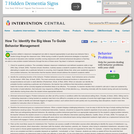
Teachers skilled in classroom management are able to respond appropriately to just about any behavior that a student brings through the classroom door. While having a toolkit of specific behavioral strategies is important, the real secret of educators who maintain smoothly running classrooms with minimal behavioral disruptions is that they are able to view problem student behaviors through the lens of these seven 'big ideas' in behavior management.
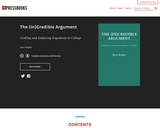
Emphasizes the logical means of supporting claims in argumentative essays, thesis statements and reasoning. Includes logic, style and research.
This project was funded by a grant from the Higher Education Coordinating Commission in Oregon, a grant that ran from July 1, 2016 to June 30, 2017. The text of the book is complete (though, in the way of these things, still evolving), but moving it online is still in progress. The chapters available here are ready to be used or copied; additional chapters will be added during July as the conversion and final copyedits are completed.
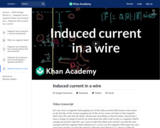
Sal determines the current and EMF induced in a wire pulled through a magnetic field. Created by Sal Khan.